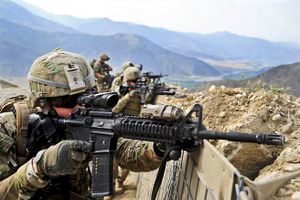Difference between revisions of "Operation Mountain Bloom"
m (→OPFOR) |
|||
| Line 26: | Line 26: | ||
==OPFOR== | ==OPFOR== | ||
| − | Most of the enemy force consisted of shooters from various, loosely-affiliated Hispanic and African-Elizian gangs. Some had military training; a few dozen or so had even seen action in Iraq and Afghanistan. These individuals had since instructed their compatriots in small-unit tactics. In addition to small arms and ballistic vests, the criminals possessed improvised explosives, ranging from pipe bombs to Molotov cocktails to light artillery. To protect against attack, they had set up a reverse-slope defense where the terrain allowed for it, and a trench system where it did not. The farm proper was rigged with assorted booby traps. | + | Most of the enemy force consisted of shooters from various, loosely-affiliated Hispanic and African-Elizian gangs. Some had military training; a few dozen or so had even seen action in Iraq and Afghanistan. These individuals had since instructed their compatriots in small-unit tactics. In addition to small arms and ballistic vests, the criminals possessed improvised explosives, ranging from pipe bombs to Molotov cocktails to light artillery. About 60 gunmen had been given additional training in infiltration tactics. They would serve as scouts and assault troops, and were armed with carbines, submachine guns, pipe bombs and knives. |
| + | To protect against attack, they had set up a reverse-slope defense where the terrain allowed for it, and a trench system where it did not. The farm proper was rigged with assorted booby traps. | ||
Revision as of 19:29, 13 December 2016
| Operation Mountain Bloom | |||||||
|---|---|---|---|---|---|---|---|
 Guardsmen of Task Force Cannabis |
|||||||
|
|||||||
| Belligerents | |||||||
| Elizio | Various gangs | ||||||
| Commanders and leaders | |||||||
| Col. Nolan Greer Col. Anna Utley | Unknown | ||||||
| Units involved | |||||||
| 1st Battalion, 2nd Mountain Brigade 4th Battalion, 5th Siege Brigade | |||||||
| Strength | |||||||
| ~1,600 16 guns and mortars | ~500 9 mortars |
||||||
| Casualties and losses | |||||||
| 33 killed 60 wounded 3 guns and mortars destroyed 2 helicopters damaged 1 heliplane shot down | ~200 killed ~80 captured 9 mortars destroyed |
||||||
Operation Mountain Bloom was an operation by the Gadsden Land Federal Guard to clear a section of the Mohawk Mountains of drug traffickers and their crops.
Background
On May 29th, 2014, a group of rangers patrolling the western Mohawks were fired upon by persons unknown. A helicopter sent to evacuate them took what was later determined to be mortar fire, but was able to take off. As the helicopter departed with the rangers aboard, the crew and passengers observed a marijuana farm spanning over 600 acres and reinforced with trenches, sangars and spider holes. The rangers informed their Regional Forester, who in turn called Governor Roy Killian. Assessing the situation as beyond any state agency's capabilities, and without cohesive federal law enforcement, Killian summoned the best assets he had—the commonwealth's Land Federal Guard.
Task Force Cannabis
The 5th Siege Brigade at Filibusters Camp, and the 2nd Mountain Brigade at Fort Mohawk, mustered a battalion each to create a task force, call sign Cannabis. 4/5 Siege deployed on a plateau to the west of the farm, while 1/2 Mountain dug in to the north. By April 3rd, they had created an L-shaped line of trenches linking their positions. 4/5's commander, Col. Nolan Greer, parceled out a howitzer battery to the 1/2 to supplement the mountain troops' mortar teams. The guns would suppress the enemy in intervals while two companies of infantry and engineers bounded across to capture critical points at each trench line, where a mounted mortar team would stay with follow-on troops to cover the advance. Air support took the form of three A-29B attack planes and an MC-27J gunship.
OPFOR
Most of the enemy force consisted of shooters from various, loosely-affiliated Hispanic and African-Elizian gangs. Some had military training; a few dozen or so had even seen action in Iraq and Afghanistan. These individuals had since instructed their compatriots in small-unit tactics. In addition to small arms and ballistic vests, the criminals possessed improvised explosives, ranging from pipe bombs to Molotov cocktails to light artillery. About 60 gunmen had been given additional training in infiltration tactics. They would serve as scouts and assault troops, and were armed with carbines, submachine guns, pipe bombs and knives.
To protect against attack, they had set up a reverse-slope defense where the terrain allowed for it, and a trench system where it did not. The farm proper was rigged with assorted booby traps.
